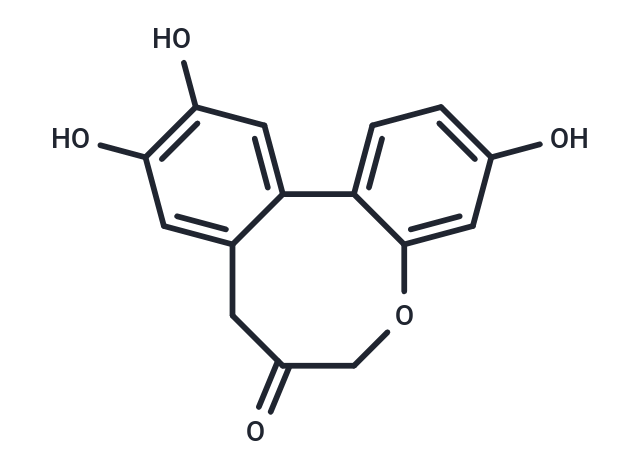 Your shopping cart is currently empty
Your shopping cart is currently empty

Protosappanin A (PTA) has anti-oxidative/nitrative activities on brain immune and neuroinflammation through regulation of CD14/TLR4-dependent IKK/IκB/NF-κB inflammation signal pathway; it exerts anti-neuroinflammatory effect by inhibiting JAK2-STAT3 pathway in lipopolysaccharide-induced BV2 microglia. Protosappanin A induces immunosuppression of rats heart transplantation targeting T cells in grafts via NF-kappaB pathway. Protosappanin A and protosappanin B have antimicrobial activity, they show both alone activities and resistance reversal effects of amikacin and gentamicin against MRSA. Protosappanin A shows strong effect against HIV-1 IN with an IC50 value of 12.6 uM.

| Pack Size | Price | USA Warehouse | Global Warehouse | Quantity |
|---|---|---|---|---|
| 1 mg | $89 | In Stock | In Stock | |
| 5 mg | $228 | In Stock | In Stock | |
| 10 mg | $372 | In Stock | In Stock | |
| 25 mg | $613 | In Stock | In Stock | |
| 50 mg | $869 | In Stock | In Stock | |
| 100 mg | $1,170 | - | In Stock | |
| 1 mL x 10 mM (in DMSO) | $208 | In Stock | In Stock |
| Description | Protosappanin A (PTA) has anti-oxidative/nitrative activities on brain immune and neuroinflammation through regulation of CD14/TLR4-dependent IKK/IκB/NF-κB inflammation signal pathway; it exerts anti-neuroinflammatory effect by inhibiting JAK2-STAT3 pathway in lipopolysaccharide-induced BV2 microglia. Protosappanin A induces immunosuppression of rats heart transplantation targeting T cells in grafts via NF-kappaB pathway. Protosappanin A and protosappanin B have antimicrobial activity, they show both alone activities and resistance reversal effects of amikacin and gentamicin against MRSA. Protosappanin A shows strong effect against HIV-1 IN with an IC50 value of 12.6 uM. |
| Targets&IC50 | HIV-1 (IN):12.6 uM |
| In vitro | Protosappanin A (PsA) and Protosappanin B (PsB) were identified from Sappan Lignum extracts. They showed activity against both S. aureus and MRSA with MIC or MIC50 at 64 (PsA) and 128 (PsB) mg/L alone. When they were used in combination with antibiotics, they showed the best synergy with amikacin and gentamicin with MIC50 (mg/L) of amikacin reduced more significantly from 32 to four (with PsA) and eight (with PsB), and the fractional inhibitory concentration index (FICI) ranged between 0.078 and 0.500 (FICI50 = 0.375). Moreover, the resistance of MRSA towards amikacin and gentamicin could be reversed by the Clinical and Laboratory Standards Institute criteria. The combined bactericidal mode could as well be synergy. PsA and PsB showed very low cytotoxicity in comparison with their promising activity against MRSA[1]. |
| Synonyms | PTA |
| Molecular Weight | 272.25 |
| Formula | C15H12O5 |
| Cas No. | 102036-28-2 |
| Smiles | Oc1ccc-2c(OCC(=O)Cc3cc(O)c(O)cc-23)c1 |
| Relative Density. | 1.476g/cm3 |
| Color | White |
| Appearance | Solid |
| Storage | Powder: -20°C for 3 years | In solvent: -80°C for 1 year | Shipping with blue ice/Shipping at ambient temperature. | |||||||||||||||||||||||||||||||||||
| Solubility Information | DMSO: 225 mg/mL (826.45 mM), Sonication is recommended. | |||||||||||||||||||||||||||||||||||
| In Vivo Formulation | 10% DMSO+40% PEG300+5% Tween 80+45% Saline: 5 mg/mL (18.37 mM), Sonication is recommended. Please add the solvents sequentially, clarifying the solution as much as possible before adding the next one. Dissolve by heating and/or sonication if necessary. Working solution is recommended to be prepared and used immediately. The formulation provided above is for reference purposes only. In vivo formulations may vary and should be modified based on specific experimental conditions. | |||||||||||||||||||||||||||||||||||
Solution Preparation Table | ||||||||||||||||||||||||||||||||||||
DMSO
| ||||||||||||||||||||||||||||||||||||
| Size | Quantity | Unit Price | Amount | Operation |
|---|

Copyright © 2015-2025 TargetMol Chemicals Inc. All Rights Reserved.